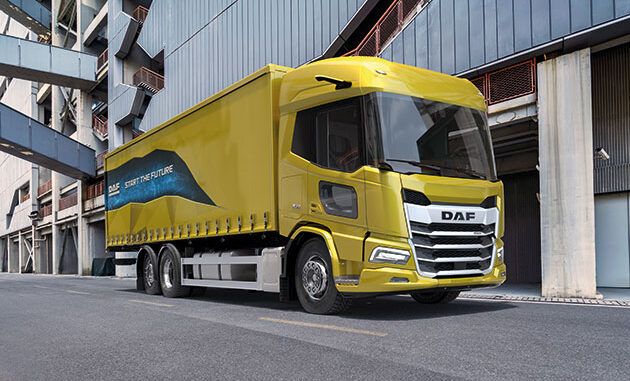
The legendary Transport News road test returns with a new XG truck provided by Lothian DAF and a new driver behind the wheel.
LAST year DAF Trucks unveiled three completely new cabs; the XF, XG and XG+.
Officially, both the XG and XG+ are the biggest production series cabs available on the open market, taking the ‘maximum benefit from the new European Commission (EC) masses and dimensions regulations’, writes Kevin Swallow.
In short, the regs allow manufacturers to fit aerodynamic devices and designs to trucks that are intended to reduce fuel consumption. While there is no specific restriction on additional length, changes must not exceed current turning circle regulations and not increase a vehicles load space.
For safety at the front of the cab a metre up from the ground the design must slant backwards by 3%, so in the event of a collision with a vulnerable road user, they are knocked ‘into the vehicle’ rather than underneath. For aerodynamics the sides of any forward appendage must be tapered by at least 20 degrees.
Expect other truck manufacturers to follow suit when they launch new cabs.
Back to the here and now, and Transport News got its hands on an XG 6×2 with the 530hp engine. The top of the range kerbweight are similar. The old XF Super Space cab is around 200kg lighter than the new generation XF. The new XG+ with its extras is just a ‘few kilos’ heavier than the XF Super Space cab.
This like-for-like weight has been achieved by using thinner but higher-strength steel for the cab structure, and a new style front end of the chassis designed to go with the new cab.
The front end XG protrusion is 160mm, which, according to the manufacturer, achieves the optimum aerodynamic benefit contributing 3% improvement.
DAF has redesigned the rear axle suspension to include a new geometry as well as a new fifth wheel position, resulting in an extended 4.0m wheelbase for the XG range for superior ride and handling. The XG cab gets an extra 330mm of length behind the B-pillars.
Choice of engine for the XG is the MX-11 450hp and the MX-13 at 430, 480 and 530hp. Torque is increased in both engines by 50Nm to 100Nm in direct drive top gear, the top-rated 530hp version now offers 2,550Nm in every lower gear and 2,700Nm in top gear.
A new generation HE400 turbocharger improves air management, further strengthening DAF’s down-speeding performances with maximum torque now available at 900rpm, even for the 530hp MX-13 engine.
Inside the DAF reveals a greater range of steering column adjustment, as well as swivel seats for the driver and passenger and a new multifunction steering wheel. A standard fit 12in primary display is fully digital and features a high level of configuration, with most functions accessible from the steering wheel. Towards the centre of the dash, the 10in secondary touchscreen display is optional, and controls navigation and infotainment.
For 40 winks, the mattress across all three cabs is 2,220mm long, while in the XGs it has a minimum width of 800mm.
The New Pilot
The new official ‘road test’ driver for Transport News is Stevie Walker, who co-owns Lochmaben Transport based in Lockerbie. He took the DAF XG 530 FTG 6×2, supplied by Lothian DAF, around the test route, accompanied by DAF Truck UK’s press and demonstration driver Mandy Wannerton.
TRUCK manufacturers are trying hard to create an environment that drivers want to be in, writes Stevie Walker.
While there are no real bad trucks these days, the XG appears to be on another level. The extended cab dimensions give a great feeling of space, nights spent out in this cab can only be a more pleasurable experience, especially with one of the best mattresses I have ever seen, which has a fully motorised raising of the backrest and knee area.
It’s complemented by well-placed switchgear that controls the internal lights and heating, and the ability to switch on DAFs Digital Vision System (DDVS) cameras to see what’s happening outside. Switches and controls are well placed, and the steering wheel has plenty of adjustment and the stylish leather seats both swivel, with the driver’s seat having hot and cool options.
And it’s good to see the cup holders have been given priority; an area often overlooked, but it is a fundamental piece of cab design that makes a driver’s day more tolerable. In the XG the cup holder is centrally located below the main dashboard and is a malleable material that adapts to the size of the cup, eliminating lateral movement and spilling the contents onto whatever else is kept around about it.
There are plenty of flat surfaces, including a pull-out tray from the dash, for meals or laptops, and overall storage is excellent. A central 10.1in touch screen controls the infotainment system with built in sat-nav, this all seems very user friendly, and I even managed to sync my iPhone without watching a YouTube tutorial.
In peak summer weather, I cursed myself for forgetting my sunglasses, so was reliant on the sun visor. It is one of the few things in this cab not to be upgraded, although still satisfactory I much prefer the motorised system in the Volvo FH.
Within a couple of minutes with a few adjustments I find myself settled in and straight away appreciate the level of comfort involved in driving the XG. Mandy immediately comes into her own, and she encourages me to take advantage of the systems designed to get the best out of the truck.
Things like the improved Adaptive Cruise Control (ACC) combined with the powerful MX engine brake, which allows you to relax a bit and let the truck sort itself out. I’m not alone in finding that when using the ACC system, you occasionally creep up behind a slower moving vehicle and not notice that you have matched its speed for a couple of miles. This could easily be remedied with a visual (or audio?) alert on approach allowing you to maintain your desired speed.
One of the best features of the new model is the enormous, curved windscreen which gives an unparalleled view of the road, combine this with the internal mirrors, sorry Mandy, monitors’, there is virtually no blind spots.
The DDVS, like others on the market, are a contentious issue. I’ve yet to find a driver who likes them or finds them a necessary addition. However, after a day with DDVS I must agree that they do have a lot to offer. DDVS help eliminate major blind spots, it improves fuel economy, reduces wind noise, don’t fog up or get wet or dirty.
You are not going to clash mirrors with another wagon on a narrow road, the view of the trailer is improved because when manoeuvring they adjust as you turn. And the Class V monitor offers a view of the front left-hand and near sides you could only dream of, which at some point will most certainly save lives.
I still can’t get used to the look of the truck with no mirrors though, and there are still some improvements to be had in resolution as it is still difficult to make out fine detail in the rear distance.
On the Edinburgh Bypass, with a bit of standing traffic up ahead, Mandy encouraged me to let the DAF technology do the work and pull itself up, I bottle it at the last minute and with a disapproving look from Mandy I realise that, if I allowed it, the XG would’ve had it all under control.
On the A702 the truck requires more input from me as the road twists and turns its way towards Abington. I found the steering to be very positive and the lack of mirrors is a definite benefit on this road as we met several oncoming HGVs on the narrower sections.
I try my best to use ACC where possible adjusting my speed using the controls on the left of the steering wheel, as well as MX engine brake. It is increasingly frowned upon to use your feet when driving a truck these days as unnecessary and excessive braking and accelerating only costs time and money.
The XG sits well on the A702, and we maintain steady progress with the use of the speed limiter to keep us legal at 40mph until we get back on the M74.
Back at Lockerbie Truckstop over a cup of tea, I mulled over the truck. I realise that the 191-mile journey has taken absolutely nothing out of me. This is testament to the levels of comfort and the ease of driving the XG.
It is exactly what the industry needs to help attract drivers to what can often be an unattractive job. Mandy demonstrated that to get the most out of modern trucks, operators must take advantage of training offered by manufacturers, something often overlooked by operators. I am guilty of this myself as we struggle to find time to get drivers away from their day-to-day duties.
The new XG cab is industry leading, save for the taller XG+, and it handled the route with ease. From a driver’s perspective, DAF has got it right, it’s a much easier days’ work behind the wheel of this truck.
Specification: DAF XG FTG 530 6×2 tractor unit.
Cab: XG with Comfort Plus Pack and Executive Pack.
Engine: MX-13, multi torque six-cylinder 12.9-litre diesel.
Max power: 523hp (390kW) at 1,600rpm.
Max torque: 2,550Nm (first to 11th gear) and 2,700Nm (in top gear) at 900-1,125 rpm.
Gearbox: TraXon 12TX2620 automated 12 speed, direct drive; ratios, 16.69-1.00:1.
Wheelbase: 3,950mm.
Suspension: Front, parabolic leaf suspension with shock absorbers and stabiliser; mid and drive axles; air with shock absorbers and stabiliser.
Parking brake: Pneumatic park brake control.
Secondary brake: MX Engine Brake, hydraulically operated compression brake assembly integrated in the valve rocker group working simultaneously with the exhaust brake.
Steering: Variable assisted recirculating ball.
Wheels: Alcoa 22.5x9in aluminium on all axles.
Tyres: Front and rear axle, 315/70R22.5 Goodyear type FMXSE (Energy); mid axle, 315/70R22.5, Goodyear type FMXSE (Energy); drive axle, 315/70R22.5, Goodyear type FMXDE (Energy).
Fuel/AdBlue Tank capacities: 710 litres, 490 litres LHS and 220 litres RHS/85 litres AdBlue.
Plated weights: Front axle, 8,000kgs; mid axle, 6,500kgs drive axle, 11,500kgs.
Chassis-cab kerbweight: 8,988kg (full tanks, no driver).
Trailer:
Weather: Dry with 10mph south-westerly wind. Temperatures peaked at 29 degrees.
Date: 10th August 2022.
Route: Starts at Lockerbie Truckstop heading north from M74 J16 to Glasgow J4 and joins the M73 towards Denny then M80 north past Stirling. At Dunblane, onto the A9 past Auchterarder to Perth and join M90 south towards Kinross and onto Forth Road Bridge. Turn onto the eastbound M8 then around A720 Edinburgh bypass to A702 heading southbound passing Penicuik and Biggar. At Abington Motorway Services re-join M74 J13 southbound to M74 J16 and finish at Lockerbie Truckstop. 191.5 miles.




